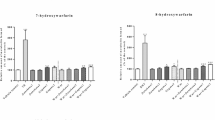Summary
Danggui is a popular traditional Chinese medicinal (TCM) herb which is easily obtained by the public. The effects of Danggui on the pharmacokinetics and pharmacodynamics of warfarin were studied in rabbits.
Single subcutaneous doses (2 mg/kg) of warfarin were administered to 6 rabbits with or without 3 days treatment with oral Danggui extracts (2 g/kg twice daily). Plasma warfarin concentrations were measured by high performance liquid chromatography (HPLC) for 72 h after each of the two warfarin doses. The prothrombin time (PT) was measured daily for 3 days both during the Danggui treatment period and after warfarin doses. Danggui treatment did not affect PT on its own, but significantly lowered PT values 3 days after co-treatment with single dose warfarin. No significant variations in the single dose pharmacokinetic parameters of warfarin were observed after Danggui treatment.
A separate group of 6 rabbits were given daily subcutaneous doses of warfarin (0.6 mg/kg) to achieve steady state level, followed by 3 day treatment with oral Danggui extract (2 g/kg twice daily). The slight increase in PT was not significant and two rabbits died after day 7 of the treatment period. However, there was no significant difference in steady state concentrations of warfarin after the Danggui treatment. Results indicate that precautionary advice should be given to patients who self-medicate with Danggui or other TCM products while on chronic treatment with warfarin.
Similar content being viewed by others
References
Chou Y.P. (1979): The effects ofAngelica sinensis on haemodynamics and myocardial oxygen consumption in dogs. Acta Pharma. Sinica, 14, 156.
Tang W., Eisenbrand G. (1992):Angelica species, In: Chinese Drugs of Plant Origin: Chemistry, Pharmacology, and Use in Traditional and Modern Medicine. Germany, Springer-Verlag, pp. 113–125.
Chang H.M., But P.P.H. (1986): Danggui. In: Pharmacology and applications of Chinese Material Medica, Vol 1. World Scientific Publishing Co. Ltd, pp 489–505.
Wei Z.M. (1985): A study on the electro-physiology in antiarrhythmia effect ofAngelica sinensis. J. Beijing College Tradit. Chin. Med., 8, 40–51.
Tu J.J. (1982): Haemorheological observation after acute ischaemic apoplexy treated withAngelica sinensis. J. Tradit. Chin. Med., 23, 762–770.
Tao J.Y. (1984): Studies on the antiasthmatic action of ligustilide of Danggui,Angelica sinensis (Oliv)Diels. Acta. Pharm. Sinica, 19, 561–567.
Tanaka S. (1977): Studies on anti-nociceptive activities of aqueous extracts from different varieties of Danggui. J. Pharm. Soc. Jpn, 91, 14–24.
Wang Z. (1988): Sodium ferulate is an inhibitor of thromboxane A2 synthetase. Acta. Pharm. Sinica, 9, 430–438.
Xu L.N. (1990): Effect of sodium ferulate on arachidonic acid metabolism. Acta Pharm. Sinica, 25, 412–423.
Ma L.F. (1988): The effect ofAngelica sinensis on mouse marrow haemopoiesis. Chin. J. Haematol., 9, 148.
Wu W.T. (1989): Biological activities ofAngelica sinensis and ferulic acid on the murine spleen lymphocytes. J. China Pharmaceut. Univ., 20, 219–225
Huang K.C. (1993): Herbs affecting the uterus. In: The Pharmacology of Chinese Herbs. CRC Press, pp. 247–248.
Lo A.C.T., Chan K., Yeung J.H.K., Woo K.S. (1992): The effects of Danshen (Salvia miltiorrhiza) on pharmacokinetics and pharmacodynamics of warfarin in rats. Eur. J. Drug Metab. Pharmacokinet., 17, 257–262.
Chan K., Dehghan A. (1978): The isolation and determination of neostigmine, pyridostigmine and their metabolites in human biological fluids. J. Pharmacol. Meth., 1, 311–320.
Chan K., Woo K.S. (1988): Determination of warfarin in human plasma by high performance liquid chromatography, Meth. Find. Exp. Clin. Pharmacol., 10, 699–703.
Breckenridge A.M. (1977): Individual differences on the response to oral anticoagulants. Drugs, 14, 367–375.
Park B.K. (1988): Warfarin, metabolism and mode of action. Biochem. Pharmacol., 37, 19–27.
Bjornsson T.D., Meffin P.J., Swezey S. (1979): Clofibrate displaces warfarin from plasma proteins in man: an example of a pure displacement interaction. J. Pharmacol. Exp. Therap., 210, 316–321.
Author information
Authors and Affiliations
Rights and permissions
About this article
Cite this article
Lo, A.C.T., Chan, K., Yeung, J.H.K. et al. Danggui (Angelica sinensis) affects the pharmacodynamics but not the pharmacokinetics of warfarin in rabbits. Eur. J. Drug Metab. Pharmacokinet. 20, 55–60 (1995). https://doi.org/10.1007/BF03192289
Received:
Issue Date:
DOI: https://doi.org/10.1007/BF03192289




